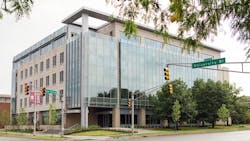Administration building at IUPUI gets LEED Gold rating
University Hall at Indiana University-Purdue University Indianapolis (IUPUI) has become the fifth certified green building on campus.
The $22.9 million five-story facility, with about 100,000 square feet of space, opened in 2015. Its design and construction has received LEED Gold certification from the U.S. Green Building Council, which created the rating system to evaluate the environmental performance of a building.
The building houses IUPUI's administrative offices.
Among the sustainable elements that contributed to University Hall's Gold rating:
- Bike lanes and bus routes situated close to the building.
- Preferred parking is for carpools and high-efficiency vehicles.
- A stormwater-detention system designed to reduce runoff from the site by 92 percent.
- 32 percent less water consumption compared with a similar non-green building.
- A curtain wall on the south side of the building that maximizes daylighting potential.
- An L-shaped floor plan that makes it easier to bring daylighting to the interior of the building.
- Horizontal and vertical sunshades on the curtain wall that reduce heat gain and glare.
- Constructing the facility with 43 percent recycled materials and 60 percent materials that were sourced within 500 miles of Indianapolis.
Other IUPUI buildings with LEED certification are the Science and Engineering Laboratory Building, the Eugene and Marilyn Glick Eye Institute, the Neuroscience Building, and the Rotary Building.
By being a leader in the construction of LEED buildings, the university is helping to change the building market, says Jessica Davis, director of the IUPUI Office of Sustainability.
"When organizations construct LEED buildings, they demand more sustainable products," she says. "As the supply of sustainable products increases, the price drops, making them more financially accessible for buildings that are not designed to LEED standards. LEED buildings are a positive driving force in the sustainable-construction market."
About the Author
Mike Kennedy
Senior Editor
Mike Kennedy, senior editor, has written for AS&U on a wide range of educational issues since 1999.
